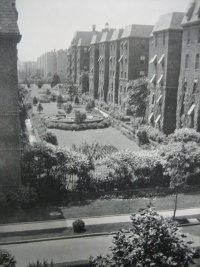Founding the neighborhoodFrom The Peopling of New York CityJackson Heights was not always an embodiment of diversity. As a matter of fact, in 1909, Edward MacDougall and the Queensboro Corporation designed 325 acres of pure farmland into a lush neighborhood with garden apartment complexes, private courtyards, and tree-lined sidewalks to appeal to white, middle class New Yorkers. The apartments also offered other comforts such as tennis courts, golf courses, athletic fields, interior gardens, and playgrounds. (Community Greens: Jackson Heights). The developers' goal was to create a serene, upper-class utopia away from the humdrum of crowded, immigrant city life (Kasinitz, 163). In seeking this vision, early developers actively screened potential residents and asked for references, effectively barring both Jews and African-Americans from the neighborhood. While Jews were finally admitted into the neighborhood in the late 1940s when they were accepted as "white," African-Americans “continued to be excluded from the area until … 1968 [and possibly] through the 1980s” (Kasinitz, 163-4). Even today, African Americans are an underrepresented ethnic group in Jackson Heights. In 1919, Jackson Heights was one of the first neighborhoods to establish a "cooperative ownership plan," in which residents "became shareholders in the complex" (Kasinitz, 163). This plan led to the rapid settlement of the neighborhood during the 1920s. By 1930, Jackson Heights was home to nearly 40,000 residents (Kasinitz, 163) although the neighborhood catered primarily to white ethnics, including Irish, Italians, and White Anglo-Saxon Protestants. An influx of ethnic minorities would soon change the defining characteristics of Jackson Heights, contributing to the neighborhood's supposed decline in the 1970's.
|

